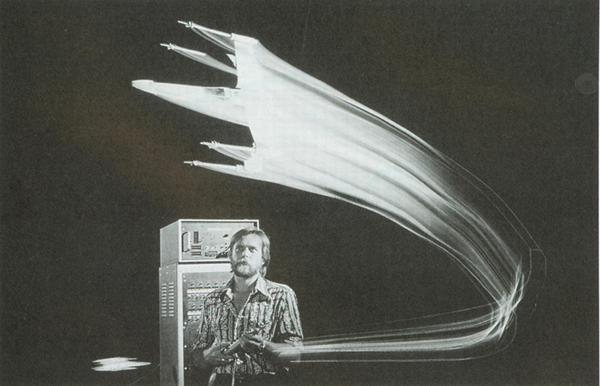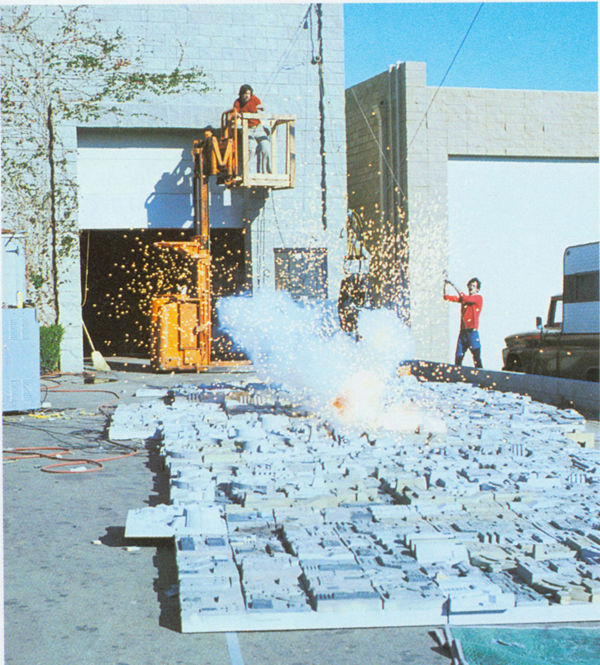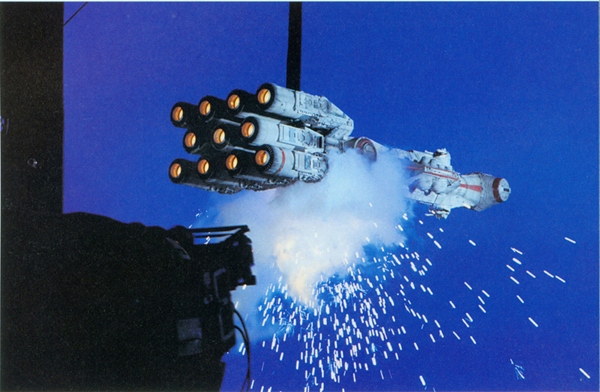Written by the Propstore team
For the explosion shots, Dykstra’s team built effects models that were pre-ordained to die out of a breakaway mold-making material that master modeler Grant McCune brought to the table called “fast tool.” “I didn’t want it all just to go bang,” Dykstra says. “I wanted it to go bang, bang, bang, bang, and, you know, have different parts explode at different times.” To create the appropriate symphony of bangs, ILM tweaked the chemistry of the fast tool in order to manipulate the material’s structural integrity to their needs. The internal parts of the pyrotechnic models also had to be painted so that discerning viewers going through the film in detail would not be able to pick out bare fast tool fragments tumbling through space. As with most of the STAR WARS visual effects, the exploding ships were not a simple, one-element process. Each explosion was the result of detailed compositing. “In some cases, we shot bigger explosions to overlay over existing, smaller explosions to help give more punch to it.” In the days before computer-generated anything, this compositing was not a quick process. It was often frustrating and always delicate and tedious.

The ships were built and the detonators were primed. Now, someone had to fly these things. And it wasn’t going to be Han Solo behind the wheel. It was going to be John Dykstra, the man who now had to put his money where his mouth was and prove to Lucas and Kurtz that he could create all the miracles he had promised them when they hired him. “From George’s point of view, it was tough to believe that we were going to be successful with this stuff. As we went forward, we ad to build the cameras before we could prove that the miniatures were going to work, [the miniatures] before we could prove that the optical composites were going to work… He got frustrated. And I’m sure there were a lot of times that he would have preferred to do the stuff as physical effects.”

Essentially, Dykstra was asking George Lucas for the same faith in him that Lucas received from Alan Ladd, Jr. and 20th Century Fox when they greenlit STAR WARS. Most directors are control guys, which is part of what cuts them out for the job. But the flip side of that is that they hate not being in control, something Lucas surely felt in those early days when he was trying so desperately to see his vision realized. Despite the anxiety, despite concerns about a hundred different factors standing between STAR WARS and oblivion, the show went on. “I don’t know whether it was [George Lucas] or Gary Kurtz or what, or momentum, but there was follow through on it.
More than anything else, Lucas—and the whole of 20th Century Fox, for that matter—was putting his faith in the motion control aspect of Dykstra-vision. In the STAR WARS 1970s, computers were just beginning to come onto the larger industrial scene. They were still more than a decade away from popular individual use. Like mostly everything else ILM created for STAR WARS, the cameras and camera rigs had to be invented before they could be used. In a turn from kit-bashing to circuit-bashing, Dykstra oversaw the construction of the computer boards as they were built out of component electronics that his team collected. The end goal was similar to what he was working on when Lucas discovered him at the University of California at Berkeley: programmable cameras that could be given specific, detailed tasks and repeat them again and again within strict tolerances.

“It was all about process.” “Process” at the time meant inventing this so that they could shoot that, putting this subject here instead of there, re-engineering the optical printers, the film, the build materials, everything in the name of getting to the end goal of shooting what needed to be shot. Speak to Dykstra about STAR WARS and you’ll hear the word “process” frequently repeated.
This particular process was all leading to the models moving during exposure at the same time the cameras did. This created motion blur, another facet of the visual effects that made everything seem a bit more real in STAR WARS. “If you look at a stop motion animation, on an individual frame, the subject is sharp and in full detail. If you look at a picture of a car going by on a street shot on a motion picture camera, the car itself is streaked because there’s movement during exposure.” In a stop-motion shot, still photographs of a model that is moved frame-by-frame are taken and then played back as a motion picture to create the illusion of movement. In STAR WARS, it wouldn’t be an illusion; the models would actually be moving, an effect that had never been achieved before with miniatures.
As the camera rigs came together, Dykstra worked on adding their most critical feature: the tilting lens port. Built onto the front of the camera, this is an old technique from still photography that helps to create an enormous depth of field. That is, the portion of a photographed image that remains in acceptable focus. Dykstra illustrates with the props available on the table in front of him. “You put the forks and knives in the foreground and you want to keep the other side of the notebook in focus, you do that with a conventional camera, either these (the forks and knives) will be soft (out of focus) or that (the notebook) will be soft. But if you use a tilting lens port, you can tilt the lens. And by tilting the lens, you can carry depth of field (focus on all the subjects) all the way from there to there.” Adding the tilting lens port to the Dykstraflex camera system made it so that as the model miniature and the camera came closer and closer together, the operator could keep the entire subject in constant focus. This little trick helped to create something crucial to creating believable spaceships and interstellar combat: scale. “[Depth of field] was a critical part of making people who were watching the film believe that these things were big, was that they carried depth of field.”
Even after ILM got the shots they needed, they had to turn to the fussy and fickle optical printer. Before the days of digitized footage and fancy software packages, visual effects were created in an optical printer, which is essentially two or more film projectors mechanically linked to a movie camera. Together, the rig allows the operator to re-photograph strips of film.
In a word—compositing. But there are limits to optical printing, beginning with how much film one could feed into the printer. The longer the effects shot, the more chances (frames) there were to ruin it during the optical printing process. Perhaps Dykstra himself illustrates best. “Multiple ship shots were hard because of the limitations of optical printing. You put twelve pieces of film through the optical printer and after twelve or thirteen pieces of film, the film started to get damaged and so you’d get to a point where if you had to make three passes on something… you look at the final product and you go ‘you know, that ship’s just a little too blue.’ So they go back and they do everything again, but the next time through, they had scratched the separations from one of the elements. Well if you made new separations, the new separations weren’t the same as the old separations, so you had to go back and run the old elements that weren’t scratched with the new element that had been generated, and then there’d be color skews…” At times, the very process that Dykstra preached seemed like it could be their undoing. “The number of elements increased the amount of work for a given shot exponentially.” The optical printer was at the center of achieving the vision laid out on the storyboards, many of which included multiple separate elements (i.e., different ships) that had to be composited onto one image. If Dykstra’s team couldn’t get the optical printer to do what they needed it to do, all that process would be for naught. Much like everything else at ILM, the things they were doing with the optical printer had never been done before. “The technique itself had been used before, but the way we were using it was relatively new.”
Even after tackling the veritable menagerie of issues associated with the visual effects for the spaceships, Dykstra and ILM weren’t out of the Endor woods yet. Other never-before-attempted challenges remained, perhaps chief among them was the most iconic invention in George Lucas’s STAR WARS universe: the Jedi’s lightsaber.
Dykstra recalls the first (mis-)step of making the prop team’s lightsabers work. “I started out the deal with the lightsabers by suggesting that we put retro-reflective material on sticks and shine[d] a light from the camera.”
There wasn’t discussion at the time about making the lightsaber blades different colors, necessarily, but Dykstra knew it would be possible to make them essentially any color in postproduction. “We just knew we could make the lightsabers whatever color we wanted by filtering the light. But of course with two lightsabers in the same scene, that became problematic because the light source hit them both.” The approach presented even more problems that confounded the effect. It was awkward for the actors to wield convincingly and didn’t achieve the visual effect that Lucas had envisioned. Dykstra therefore turned to compositing via rotoscoping, essentially animating the lightsaber’s blade frame-by-frame in post-production. While time-consuming and tedious with the technology available in 1976, this technique created much more freedom for the actors, director of photography, and ILM. “Of course with rotoscoping, we had no problem. We could make them whatever color we wanted.” Still, a vestige of the practical effect survives in the famous duel between Obi-Wan Kenobi and Darth Vader on the Death Star, where the bitter adversaries do battle with Dykstra’s rather impractical retro-reflective sticks. He laughs, “You can tell [it’s practical], because when you bring [the lightsabers] together, stuff flies off of them!”
So much wizardry was created at ILM that it might be easy to look past the seemingly simple hyperspace effect, or as Dykstra refers to it—“star streak and disappear.” “We didn’t know what we were going to do until the last minute… and we just started talking about doing some kind of streak photography, which is something that Doug Trumbull was known for (from his work on 2001: A SPACE ODYSSEY) where you do open exposure and make the camera move during the exposure to get these smears (the stars)… so this was sort of a very simple version of 2001.” In theory, it should have worked. In practice, it ended up working perfectly. “It was one of those deals where it was serendipity… We essentially took something that we already knew was going to be something and tried it. And it was successful.” One can surmise that such serendipity was a welcomed guest at ILM.
Dykstra’s Los Angeles shop also served as somewhat of a visual effects triage center, performing emergency surgery on effects that had gone awry in England. A famous example of this is Luke’s landspeeder, an aborted bluescreen effect that can be seen in its original form in the EMPIRE OF DREAMS documentary, among other places. It’s Dykstra’s opinion that ILM saved the landspeeder effect from certain cutting-floor doom. “[The landspeeder recreation] may have been something he decided he needed [to re-do] after he started cutting the picture together. That was my impression.” ILM touched up the Ogle Noor body, got the mechanical guts running, and added the mirror to the side for the distance shots that would make the vehicle appear as if it were hovering over the desert’s surface.
For pickup shots that would need to be intercut seamlessly with what was already shot in Tunisia, ILM and Dykstra packed up and journeyed into the deserts outside Los Angeles. ILM shot pickups all over the areas in and around the ghost towns of Death Valley, including Searles Lake and the Trona Dry Lake. Visible in the shots of the Jawas’ sandcrawler miniature are the Randsburg mountains that once contained rich gold mines. “That’s where [you see] those funny-looking mountain shapes that are behind the sandcrawler, where it’s going through the canyon.”
With such attuned forward-looking vision, it’s hard to believe that Dykstra didn’t know he and his ILM team were in the middle of creating history. But when asked if he had any idea how huge STAR WARS was going to be, Dykstra modestly parries. “I didn’t know how big it was going to be, I just knew I was having a good time doing it.”
Ain’t that the truth. During production, ILM’s Southern California operation was associated more with a twenty-four hour party than a place where any serious film production was going on.
Like any self-respecting visual effects crew, Dykstra’s team then set about discovering the best way to blow these models up.
Be sure to check out our great range of Star Wars items currently listed on our website here.